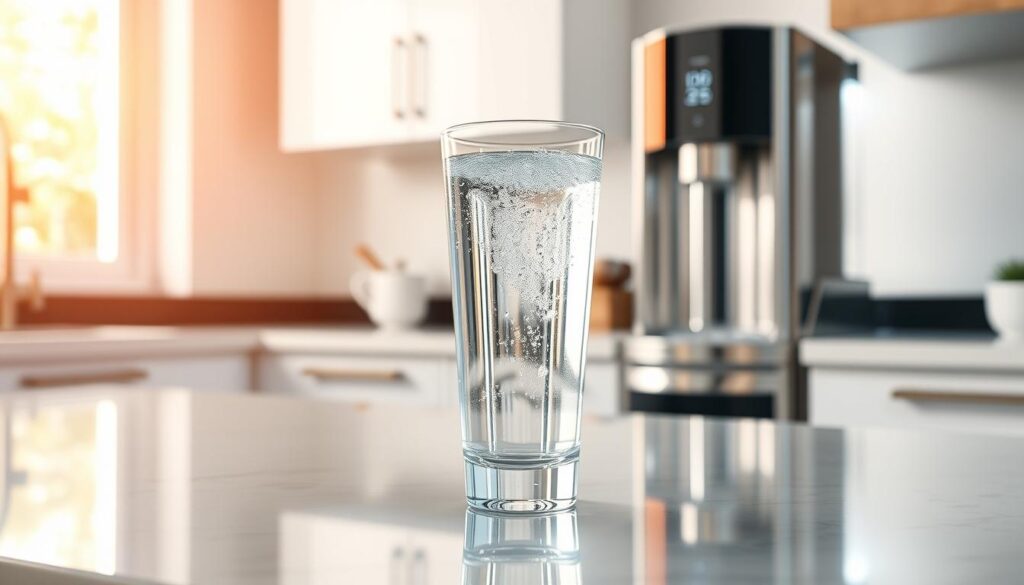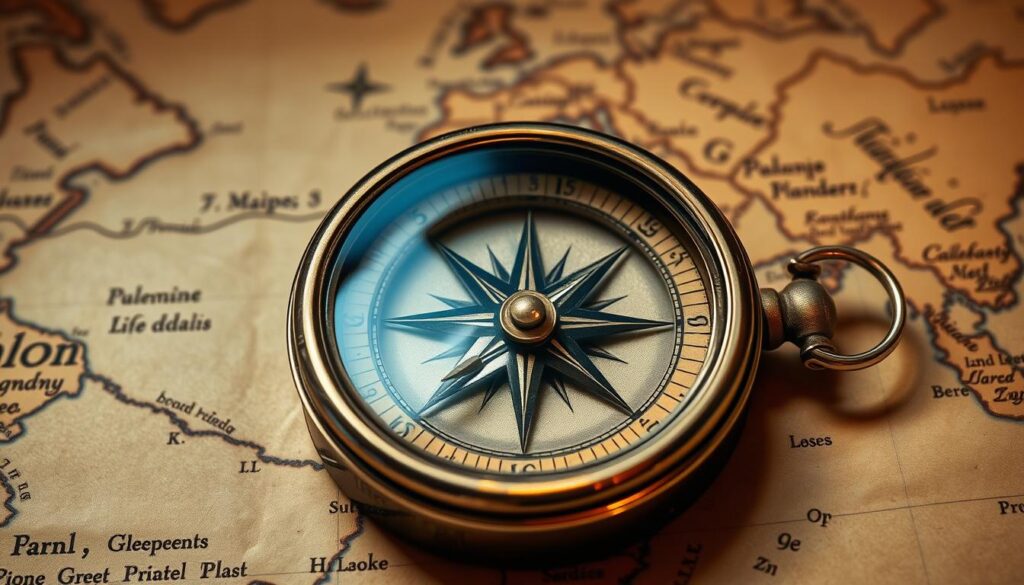Thinking about clean drinking water makes me realize how precious it is. Pure water is becoming increasingly scarce due to pollution and environmental concerns. This makes finding new ways to purify water very important.
Scientists and researchers are doing their best to solve this problem. They’ve come up with new technologies to make clean drinking water available everywhere. By figuring out how to purify water reliably, we can make sure future generations stay healthy.
Key Takeaways
- Clean drinking water is becoming increasingly scarce due to environmental concerns.
- Innovative solutions are being developed to address the growing need for water purification.
- Reliable water purification technologies can provide clean drinking water for communities worldwide.
- The development of cutting-edge technologies is critical for a healthier future.
- Researchers and scientists are working together to unlock the secrets of pure water.
Understanding the Importance of Water Purification
Having clean water is key to public health. We use water for drinking, cooking, and cleaning. But, dirty water can harm us, making purification vital.
The Health Impacts of Contaminated Water
Dirty water can cause many health problems. This includes stomach issues and serious diseases like cholera and typhoid. Harmful bacteria, viruses, and parasites in water can be very dangerous, harming people in areas with bad water treatment.
Dirty water’s effects don’t stop at immediate sickness. It can also make people more likely to get infections. And, it can harm children’s growth and development because of long-term exposure to bad water.
Essential Elements of Clean Water
Clean water has no harmful stuff in it and has good minerals. Good water purification removes bad stuff but keeps the good minerals.
A good water purification system must get rid of many contaminants. This includes bacteria, viruses, heavy metals, and chemicals. This makes the water safe for drinking and other uses.
The Role of Water Quality in Daily Life
Water quality is very important in our daily lives. It affects our health, hygiene, and overall well-being. Using clean water for drinking, cooking, and personal hygiene lowers the risk of waterborne diseases, helping us stay healthy.
Clean water is also key for the environment. It helps keep ecosystems healthy and ensures water is used wisely for the future.
Types of Water Contaminants
Water quality is impacted by many contaminants. These can be biological, chemical, or physical. Knowing about these contaminants and their effects is key to clean water.
Biological Contaminants
Biological contaminants include bacteria and viruses. They can cause health issues, from mild to severe. For example, E. coli in water can be dangerous.
These contaminants often come from poor sanitation. Keeping water sources clean is vital to stop their spread.
Chemical Pollutants
Chemical pollutants come from many places. This includes industrial waste and household chemicals. Heavy metals and pesticides are harmful to health.
Heavy metals like lead can harm the brain. Pesticides can lead to cancer and other problems.
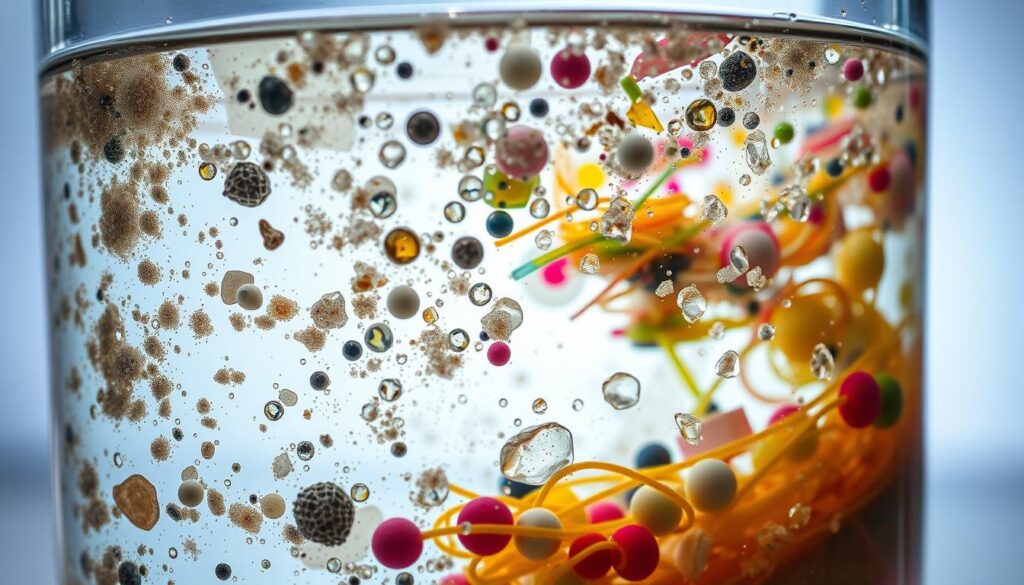
Physical Impurities
Physical impurities make water look cloudy. They include solids and sediments. While not always harmful, they can change water’s taste and look.
Methods like water filtration and reverse osmosis can clean water. They remove these impurities, making water better.
Common Water Purification Methods
To make water safe, we use several methods. These include filtration, distillation, and chemical disinfection. These steps are key to removing harmful substances and making water drinkable.
Filtration Techniques
Filtration is a common way to purify water. Reverse osmosis and activated carbon filtration are two popular methods. Reverse osmosis pushes water through a thin membrane, removing many contaminants. Activated carbon filters, on the other hand, get rid of chlorine, improve taste, and cut down on odors.
A water filter can greatly enhance water quality. It removes particles, bacteria, and other tiny organisms. The right filter depends on the water’s contaminants.
Distillation Process
Distillation boils water and then collects the steam. This steam is clean and free from many contaminants. It’s good against bacteria, viruses, and heavy metals.
The distillation process needs energy to boil the water. This makes it less efficient than some other methods. Yet, it’s a simple and effective way to purify water.
Chemical Disinfection
Chemical disinfection, like chlorination and UV water purifiers, fights biological contaminants. Chlorination adds chlorine to kill bacteria and pathogens. UV purifiers use light to do the same without changing the water’s taste or adding chemicals.
Chemical disinfection works well, but it’s often paired with other methods. This ensures all contaminants are removed.
Choosing the Right Water Purification System
Choosing the right water purification system is a two-step process. First, you need to understand your water quality and needs. This means testing your water and knowing your budget and specific needs.
Assessing Water Quality
The first step is to test your water for contaminants. Use a water testing kit or get a professional to check it. Look for bacteria, viruses, heavy metals, and other pollutants.
Knowing what’s in your water helps you pick the right system. For example, if you have heavy metals, you might need a water softener or a filter that removes them.
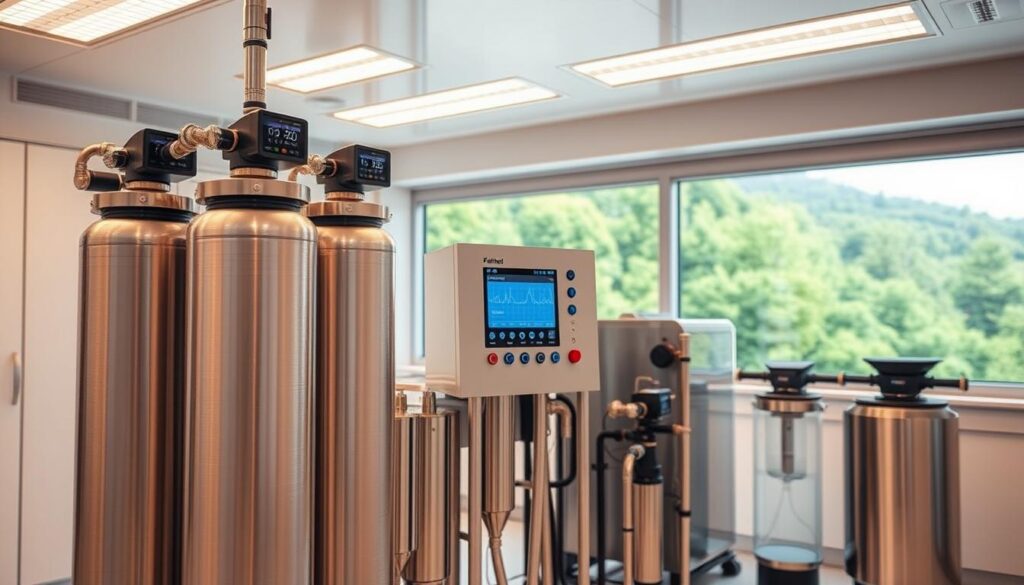
Evaluating Budget and Needs
After testing your water, think about your budget and needs. Water purification systems vary in price and effectiveness. They also have different maintenance needs.
Consider a few things when deciding:
- How big your household is and how much water you use daily
- The contaminants in your water
- The cost of maintaining and replacing the system
- Any extra features you want, like a best water purifier with a UV filter
| System Type | Effectiveness | Cost | Maintenance |
|---|---|---|---|
| Activated Carbon Filter | Removes chlorine, taste, and odor | $50-$200 | Replace filters every 6 months |
| Reverse Osmosis System | Removes up to 99% of contaminants | $200-$500 | Replace filters every 12 months |
| UV Purification System | Kills bacteria and viruses | $100-$300 | Replace UV lamp every 12 months |
By understanding your water quality and budget, you can find the perfect water purification system. This ensures you have clean, safe drinking water.
Home Water Purification Solutions
In today’s world, where water pollution is a growing issue, having a reliable home water purification system is more important than ever.
Home water purification solutions are designed to provide clean drinking water, free from contaminants and pollutants. These systems vary in technology, effectiveness, and cost, giving homeowners many options.
Popular Products on the Market
Several home water purification products have gained popularity due to their effectiveness and ease of use. Some of the top products include:
- Under-sink filters: These filters are installed under the sink and provide filtered water directly from the tap.
- Countertop filters: Countertop filters are a convenient option, sitting on the countertop and filtering water as needed.
- Pitcher filters: Pitcher filters are a simple, affordable option for purifying water.
When choosing a product, consider factors such as filtration technology, maintenance requirements, and cost.
Do-It-Yourself (DIY) Purification Methods
For those who prefer a more hands-on approach or are looking for a temporary solution, DIY water purification methods can be effective. Some common DIY methods include:
- Boiling water: Boiling is a simple method to kill bacteria and viruses.
- Activated charcoal filtration: Using activated charcoal can help remove impurities and improve taste.
- Solar disinfection (SODIS): SODIS involves exposing water to sunlight in a clear plastic bottle to kill pathogens.
While these methods can be useful, they may not remove all contaminants, and their effectiveness can vary.
Maintenance Tips for Home Systems
Regular maintenance is key to ensure your home water purification system works well and lasts long. Here are some tips:
- Replace filters regularly: Follow the manufacturer’s schedule for replacing filters to maintain water quality.
- Clean the system: Periodically clean the system according to the manufacturer’s instructions.
- Monitor water quality: Regularly check the taste, odor, and quality of the water to ensure the system is working effectively.
By following these maintenance tips, homeowners can ensure their water purification system continues to provide clean, safe drinking water.
Water Purification for Outdoor Activities
When you go outside, having clean drinking water is key. Activities like camping and hiking mean you might find water that’s not safe.
Portable Purification Devices
For safe water on the go, use portable purification devices. These include filters and tablets. They’re light and work well to remove harmful stuff like bacteria and viruses. For more info, check out this resource.
Best Practices for Camping and Hiking
To drink safe water outside, follow some key steps. Know your water sources and pick the best way to purify it.
- Always purify water from unknown sources.
- Use a combination of purification methods for enhanced safety.
- Regularly maintain your purification device.
| Purification Method | Effectiveness | Ease of Use |
|---|---|---|
| Filtration | High | Easy |
| Purification Tablets | High | Very Easy |
| Boiling | Very High | Moderate |
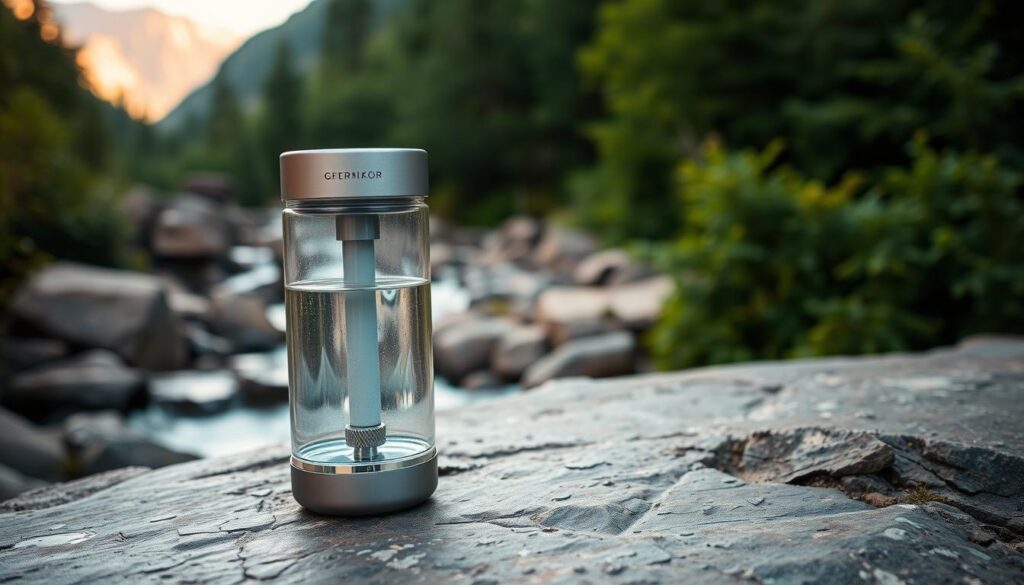
Knowing how to purify water and using the right tools and methods lets you enjoy the outdoors. You’ll always have clean drinking water.
Water Purification Regulations and Standards
Exploring water purification shows how important rules are for safe drinking water. Rules differ by country and region. It’s key to know the specific rules for your area.
EPA Guidelines and Requirements
In the U.S., the Environmental Protection Agency (EPA) sets rules for water purification. The EPA controls contaminants like bacteria, chemicals, and more. Knowing these rules helps pick a water purification system that meets EPA standards.
The EPA’s rules aim to keep drinking water safe. For example, they limit harmful substances like lead and arsenic. These substances can harm health if consumed too much.
Understanding Local Water Quality Reports
Local water quality reports are full of useful info. They show what contaminants are in your water. By looking at these reports, you can pick a water purification system that tackles these issues.
For instance, if your report shows high chlorine byproducts, a reverse osmosis system is a good choice. It removes many contaminants, including chlorine byproducts.
| Contaminant | EPA Maximum Allowable Level | Health Effects |
|---|---|---|
| Lead | 0.015 mg/L | Delays physical and mental development in children; increased blood pressure in adults |
| Arsenic | 0.010 mg/L | Increased risk of cancer; skin discoloration; cardiovascular disease |
| Chlorine Byproducts | Varies by compound | Increased risk of certain cancers; reproductive problems |
By knowing EPA guidelines and checking local reports, you can choose the right water purification system. This ensures your drinking water is safe and clean.
The Future of Water Purification Technology
Looking ahead, water purification technology is set to change how we get clean drinking water. The industry is on the verge of a big shift. New technologies will make water treatment more efficient and effective.
Innovations on the Horizon
Several exciting innovations are coming in water purification. Nanotechnology is one, using nanoparticles to clean water. It could greatly reduce heavy metals, pesticides, and other pollutants.
Smart water purification systems are also on the rise. They use advanced sensors and IoT to check water quality in real-time. This makes treatment more efficient and effective.
- Advanced oxidation processes that can remove a wide range of contaminants
- Biological treatment methods that utilize microorganisms to break down pollutants
- Graphene-based filters that offer high efficiency and durability
Advancements in Filtration Systems
Filtration systems are key in water purification, and recent improvements have made them better. UV water purifiers are getting more popular. They kill bacteria and viruses without chemicals.
Some major advancements in filtration systems include:
- Improved membrane technologies that offer higher flow rates and lower pressure drops
- Activated carbon filters that are designed to remove a wider range of contaminants
- Advanced ceramic filters that provide high levels of contaminant removal and are durable
These new developments will be vital in shaping the future of water purification. They will help us get cleaner, safer drinking water.
Environmental Considerations
When we look for clean drinking water, we must think about the environment. Water purification is key for our health but also affects the planet. We need to consider its environmental impact.
Impact of Water Waste
Water waste from purification is a big concern. Many systems, like water softeners, use a lot of water. For example, some reverse osmosis systems waste 3-4 gallons for every gallon they purify.
This waste hurts local water resources and adds to the global water shortage. It’s important to choose water purifiers that save water. Modern systems aim to waste less and recycle more.
Sustainable Purification Practices
Using sustainable practices in water purification helps the planet and saves money. Look for systems that use less energy and have a small environmental footprint.
The best water purifiers today use green energy, waste less, and are made from recyclable materials. These choices are better for our planet.
| Feature | Traditional Systems | Sustainable Systems |
|---|---|---|
| Water Waste | High | Low |
| Energy Consumption | High | Low |
| Material Usage | Non-recyclable | Recyclable |
Choosing a water purifier that follows sustainable practices helps the environment. It’s a step towards a greener future. This way, we ensure clean water for future generations.
Conclusion: Taking Action for Clean Water
Access to clean drinking water is a basic right that needs our action. Understanding the importance of water purification helps us improve our water quality. By choosing the right systems, we can make a big difference.
To ensure clean water, I should first check my water quality. Then, I need to think about my budget and what I need. This means picking Water Purification methods that fit my life, whether at home or outdoors. This way, I can always have clean drinking water ready.
Steps I Can Take Today
I can start by using simple water purification methods. This includes filters or purification tablets. If I want to try something myself, I can look at resources like EPA guidelines and local water quality reports. They offer great tips on purifying water.
Resources for Further Information
If I want to learn more, there are many resources out there. Experts and organizations share knowledge on sustainable water purification. By staying informed and taking action, we can all help make sure everyone has clean drinking water.
FAQ
What is the importance of water purification?
Water purification is key to getting clean drinking water. It removes harmful contaminants. The World Health Organization says contaminated water causes many diseases.
What are the common types of water contaminants?
Water can have many contaminants. These include bacteria, viruses, and parasites. Also, heavy metals, pesticides, and sediment are common.
How do I choose the right water purification system for my home?
First, check your water quality. Then, think about your budget and needs. Look for systems like reverse osmosis or UV purifiers.
What are the most effective water purification methods?
Good methods include filtration, distillation, and chemical disinfection. The best method depends on the contaminants in your water.
How often should I maintain my home water purification system?
Keeping your system in good shape is important. Change filters as the maker says. Do other maintenance tasks as needed.
What are some eco-friendly water purification practices?
Use filters that waste less and systems that use less energy. Also, try to use less water to help the planet.
What are the EPA guidelines for water purification systems?
The EPA has rules for water systems. They make sure systems can remove many contaminants.
How can I ensure compliance with local water quality regulations?
Learn about local water reports and EPA rules. Make sure your system meets these standards.

